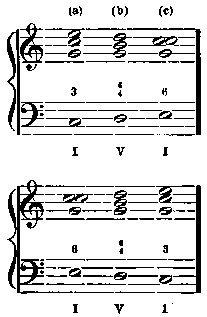Harmony Book For Beginners - online book
Scales, Intervals, Common Chords, Dominant Seventh Chord and Melody Making.
| Share page | Visit Us On FB |
|
ADDITIONAL USES OF THE SECOND INVERSION |
113 |
|||
|
CHAPTER XXVI
ADDITIONAL USES OP THE SECOND INVERSION
So far we have used the Second Inversion
 of the Tonic Chord only. We of the Tonic Chord only. Wehave done so to avoid confusion, especially in view of the fact that the Tonic is by far the most important Chord to use in this manner.
Other Chords in any Scale which may be used with good effect in the Second Inversion are the Dominant and Subdominant Chords. All these  Chords require special attention, since they are never satisfactory if allowed to stand alone. That is to say, they sound best when followed by certain other Chords, and, in some cases, when preceded by others. Young composers, and, for that matter, many who are old enough to know better frequently fail in the use of the Chords require special attention, since they are never satisfactory if allowed to stand alone. That is to say, they sound best when followed by certain other Chords, and, in some cases, when preceded by others. Young composers, and, for that matter, many who are old enough to know better frequently fail in the use of the Chord. By following the few brief directions here given, one can never go astray in this matter. Chord. By following the few brief directions here given, one can never go astray in this matter. |
||||
|
|
||||
|
We have already discussed the uso of the Tonic  The Dominant The Dominant sounds best when preceded by the Third Position of the Zbnicand followed by the First Inversion of the Tunic, or the other way about. Analyze the following example and see how it is done. Play it too, and hear how smooth it is. sounds best when preceded by the Third Position of the Zbnicand followed by the First Inversion of the Tunic, or the other way about. Analyze the following example and see how it is done. Play it too, and hear how smooth it is. |
 |
|||
|
At (a) we have the Third Position of the Tonic Chord; at (b), the Second Inversion
 of ofthe Dominant Chord; at (e). the First Inversion (6) of the Tonic Chord. Taking it the other way about, we would have it thus: |
||||
|
Note that both Melody and Bass in either example move Diatonically and in Contrary Motion. This is the best and simplest way of harmonizing such passages. It should be easily remembered.
The Second Inversion
 of the Subdominant sounds best when preceded and of the Subdominant sounds best when preceded andfollowed by the Tonic ( Root in the Bass ). Analyze the following example, play and listen. |
||||
|
|
||||
 |
||||